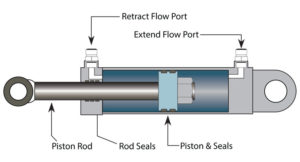It would help if you never underestimate the importance of your cylinder rod. The rod is not just the object transmitting the force from the cylinder’s piston but also the interface between that cylinder and your machine. Before you can correctly select and then design the piston rod, you must understand the potential areas of failure. The following are the top five most common piston rod problems on hydraulic cylinders.
 The rod is improperly sized for the application. This can manifest in two ways, and believe it or not, a rod can be too large. Undersized piston rods have low column strength, especially in long stroke applications. A long, thin rod will bend or break when pushing loads heavier than they’re rated. Low column strength can remedy this with a larger diameter rod or a stop tube to provide added support.Conversely, if a cylinder operates in tension, an oversized rod will actually reduce retraction force. This problem occurs at the design stage, so be sure you accurately calculate retraction force with an understanding of differential cylinders. The rod takes up area on the piston, reducing the cylinder’s force in retraction, causing the cylinder to retract with less force than it extends.
The rod is improperly sized for the application. This can manifest in two ways, and believe it or not, a rod can be too large. Undersized piston rods have low column strength, especially in long stroke applications. A long, thin rod will bend or break when pushing loads heavier than they’re rated. Low column strength can remedy this with a larger diameter rod or a stop tube to provide added support.Conversely, if a cylinder operates in tension, an oversized rod will actually reduce retraction force. This problem occurs at the design stage, so be sure you accurately calculate retraction force with an understanding of differential cylinders. The rod takes up area on the piston, reducing the cylinder’s force in retraction, causing the cylinder to retract with less force than it extends.
- Rod thread breakage. A thread may break for any of many reasons. From an application perspective, choosing the incorrect thread may be the first mistake. Thread diameter plays a part in its strength, so choosing a standard male thread when a full-size thread would be more robust is a big mistake.The quality of the thread plays a part in reliability, as well. If the radius of the thread turn-down (the gap between the rod shoulder and its thread) is not correctly machined, it leaves the window open for breakage.
- Rod scratches leading to seal damage. Rod scratches rarely affect the strength of the cylinder, especially if they’re minor. However, dents and scratches in the rod rub against the rod wiper and seal, damaging it over time.Using only rod material made from induction hardened steel will prevent dings on the surface. Also, be sure to select chrome at least a thousandth of an inch thick. A thick chrome surface further hardens the steel’s outer shell, which provides critical corrosion resistance. Corrosion on the rod also creates pits that may damage the rod seals.
- Corrosion of the rod thread. When you machine off the entire crust of the rod thread, you no longer have chrome. Because chrome protects from corrosion, the rod thread is now left to the elements. If your cylinder operates in humid environments or around harmful chemicals, corrosion or rust may weaken the rod end over time.Choose the appropriate alloy for your application. Rod material is readily available in various alloys of stainless steel. Stainless steel won’t rust, and if you order it with chrome, it provides the same surface protection as described earlier.
- Mechanical damage. Although industrial hydraulic cylinders rarely run into objects or other machinery, mobile machinery is susceptible to such accidental damage. Even the massive rods used on excavators are no match for the power of which the boom, arm and bucket cylinders are capable. Running the cylinders into a bridge upright will ding or dent a rod, no matter how thick the chrome or case hardening.
Filed Under: Cylinders & Actuators, Mobile Hydraulic Tips
